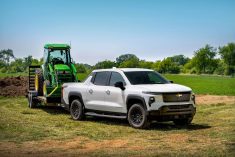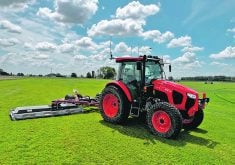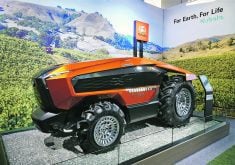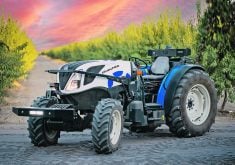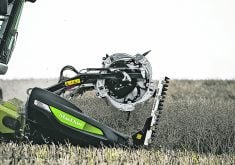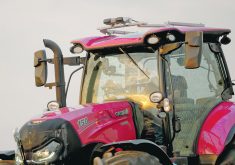Tractors with an operators’ station and an internal combustion engine are far more complicated to produce and maintain compared to autonomous, electric tractors.
This makes the barrier to entry much lower for companies that want to produce autonomous tractors, and this will put pressure on mainline equipment manufacturers in the coming years.
Tom Boe is chief executive officer of Iowa-based One3 Design, which works with companies to design and prototype products including for large agricultural equipment manufacturers.
“I’ve worked on a lot of tractors in my life, with about 30 years of design. In a tractor’s cab itself there is going to be about 1,500 to 2,000 parts,” Boe said.
“About 50 percent of the vehicle (tractor) is just to keep the operator comfortable. In our vehicle right now, we have less than a thousand parts, total.”
In the months before the pandemic business was lagging at One3 Design, so Boe started a design project to keep his engineers busy.
“We started a project to train young engineers about what we saw was going to be the future of Ag,” Boe said.
In our mindset this is autonomous operation, and in doing autonomous operation the best power source that we could come up with is electric power.”
One3 Design is on its fifth prototype rendition of its autonomous electric tractor, called Amos Power, and Boe said they are getting close to a production model.
Two models are being prototyped that are just about identical, but one is set up for 60-inch row spacing while the other has a narrow frame and is just under four feet wide for use as a vineyard tractor.
The Amos Power has two electric engines that each power a track, and a third electric engine powers the power take-off.
The track drive engines starts off with 93 horsepower, with between 75 to 85 hp getting to the ground, while the pto has 40 hp.
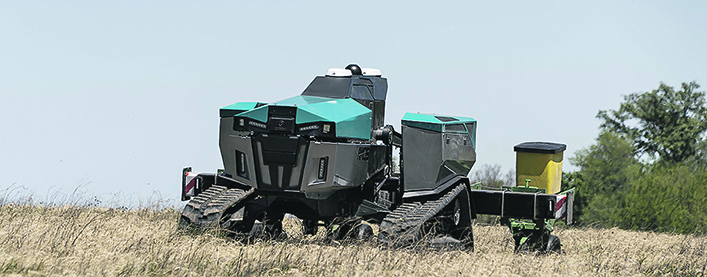
Using electric drives also made the tractor far less complicated compared to tractors with internal combustion engines.
A traditional tractor with an internal combustion engine needs a transmission, differential and axles to get power to the ground, as well as a series of clutches to break off power for implements.
“We have a left motor and a right motor. We do have gear reductions, but we use the gear reduction as an outboard planetary and that allows us to just put power where it’s needed,” Boe said.
One3 Design assembles the batteries that provide 44 kilowatt hours but is working to improve this to 75 kilowatt hours.
Operation that require a lot of power such as mowing will deplete the batteries in three to four hours, while the battery will last six to eight hours when performing less power demanding operations such as spraying.
The Amos Power tractor has a category 2, three-point hitch, and one of the design criteria of the tractor was for it to be able to use existing implements.
“We were guided by customers who were saying, ‘if I buy a new tractor, I don’t want to buy a new sprayer, I don’t want to buy a new mower. I don’t want to buy a whole bunch of new implements. I’m fine with just buying a new tractor, but I don’t want to start over with my entire farming operation,’” Boe said.
Amos Power has stereo cameras on the front and the rear that perform obstacle detection and guide obstacle avoidance operations.
For instance, if a tree has fallen in its path it can choose to go around it, or it can be set up to stop and text the operator to say there’s a problem.
“They can differentiate between a human, an animal or a tree. If it’s something that breathes within a 15-meter zone the vehicle will stop,” Boe said.
“We’re utilizing the stereo camera for obstacle detection and radar for depth. We are experimenting with lidar as well. The initial testing has always been with radar, but we are going to have an option with lidar for operations where there is heavy dust and foliage inside orchards or vineyards.”
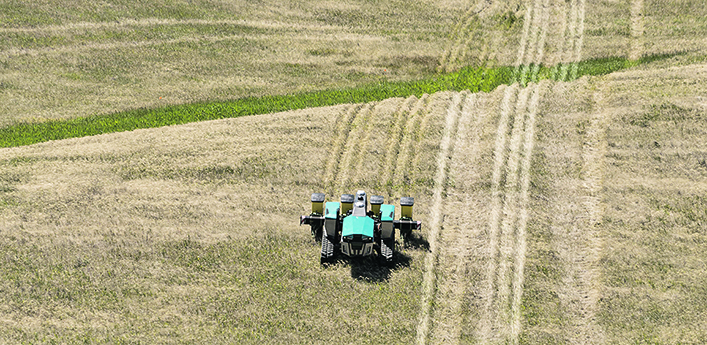
A company called RedShield Electronics provides the vehicle controller and vehicle software.
Users can set up a job by mapping it with the software on a tablet.
“You can either just touch the screen with your finger or use a mouse arrow cursor to plot the shape of the outside perimeter. You then have three or four different options, whether you want to do a spiral motion or whether you want to go back and forth like if you were planting corn. It gives you those different options, then It’ll program the field map itself and then you start the job,” Boe said.
Amos Power is CAN bus ready, so operators can not only monitor the vehicle operations and telematics, they can also remotely monitor and control implements functions.
The tractors are still in testing and are not yet rolling off a production line, but Boe said their list price will be about US$185,000.




